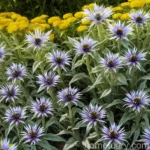Plant Profile: Mountain Bluet (Centaurea montana)
Introduction to Mountain Bluet
Mountain bluet, scientifically known as Centaurea montana, is a charming perennial plant that belongs to the Asteraceae family. It is native to the mountains of Europe, specifically the Balkans, and is also known by the common names perennial cornflower, mountain cornflower, and bachelor’s button.
The plant is valued for its striking, vivid blue flowers that bloom in late spring to early summer, adding beautiful color to gardens and landscapes. Mountain bluet is relatively easy to care for, making it a popular choice for both experienced and novice gardeners.
In this comprehensive guide, we will delve into the culture, uses, and maintenance of mountain bluet, along with essential tips and techniques for its cultivation.
Key Takeaways – Mountain Bluet (Centaurea montana)
Before we explore the specifics of cultivating mountain bluet, let’s take a quick look at the key takeaways for this delightful perennial plant:
-
Cultivation: Mountain bluet is an adaptable and resilient plant, thriving in various growing conditions.
-
Maintenance: Regular deadheading and division are essential for maintaining the health and vigor of mountain bluet.
-
Landscape Uses: This plant is versatile and can be used in rock gardens, cottage gardens, and native plant landscapes.
Now, let’s delve deeper into the various aspects of growing and caring for mountain bluet.
Culture
Mountain bluet has garnered popularity due to its versatility and relatively low maintenance requirements. Understanding its cultural needs is essential for successful cultivation.
Water
Mountain bluet thrives in moderately moist soil. It is important to water the plant regularly, especially during dry spells or in regions with hot summers. However, it is crucial to avoid overwatering, as excessive moisture can lead to root rot and other fungal diseases.
Sunlight
This plant prefers full sun to partial shade. Select a planting location that receives at least 6-8 hours of direct sunlight per day for optimal growth and prolific flowering.
Fertilizer
Mountain bluet typically does not require heavy feeding. However, applying a balanced, all-purpose fertilizer in early spring can promote healthy growth and abundant blooms. Avoid excessive fertilization, as this can lead to lush foliage at the expense of flowers.
Soil
The ideal soil for mountain bluet is well-draining and fertile, with a slightly acidic to neutral pH. Amending the soil with organic matter, such as compost, can improve its texture and fertility, providing an optimal growing medium for the plant.
Pruning
Pruning mountain bluet is a straightforward process that primarily involves deadheading spent flowers to encourage continuous blooming. Additionally, removing old, withered foliage can help maintain the plant’s overall appearance and prevent disease spread.
Propagation
Propagating mountain bluet can be achieved through division or seed sowing. Dividing mature plants every 3-4 years not only helps rejuvenate the plant but also offers an opportunity to expand your garden or share the plant with fellow gardening enthusiasts. Collecting and sowing seeds in a well-prepared seedbed can also yield new plants, although this method requires more time and patience compared to division.
Container Popularity
Mountain bluet is well-suited for container gardening, adding a delightful touch of color and texture to patios, balconies, and other outdoor spaces. When growing mountain bluet in containers, ensure that the pots have adequate drainage to prevent waterlogging, and use a high-quality potting mix to provide essential nutrients and support healthy root development.
Common Diseases
While mountain bluet is generally resilient, it is susceptible to certain diseases and pests. Understanding these potential issues is crucial for effective disease prevention and management.
Disease Diagnosis
Common diseases that may affect mountain bluet include powdery mildew, rust, and fungal leaf spots. These can often be identified by visible symptoms such as powdery white patches on leaves, yellow or brown spots, or distorted growth. Prompt diagnosis and appropriate treatment, such as applying fungicidal sprays or removing affected plant parts, can help mitigate the impact of these diseases.
Common Pests
Mountain bluet may attract aphids, slugs, and snails, particularly in humid or overwatered conditions. Regular monitoring of the plant and employing preventive measures, such as using organic pesticides or physical barriers, can help protect mountain bluet from pest infestations.
Botanist’s Tips
Experienced botanists and avid gardeners often offer valuable insights and tips for cultivating mountain bluet successfully. Here are some expert recommendations:
-
Mulching: Applying a layer of organic mulch around the base of mountain bluet can help conserve soil moisture, suppress weed growth, and insulate the roots during extreme temperatures.
-
Companion Planting: Pairing mountain bluet with compatible companion plants, such as salvia, nepeta, and catmint, can create visually appealing combinations and support biodiversity in the garden.
-
Long-Term Care: While mountain bluet is relatively low maintenance, providing consistent care and addressing any issues promptly can contribute to the plant’s long-term health and vitality.
Fun Facts
-
The specific epithet “montana” in Centaurea montana refers to its natural habitat in mountainous regions.
-
Mountain bluet’s vibrant blue flowers are a magnet for pollinators, particularly butterflies and bees, enriching the garden ecosystem.
-
In traditional herbal medicine, mountain bluet was used for its astringent properties and as a remedy for certain ailments.
Now that we have explored the various aspects of mountain bluet cultivation and care, it is valuable to access external resources for further information and guidance.
Links to External Resources
For additional insights and detailed guidance on growing mountain bluet, the following external resources are recommended:
By exploring these reputable sources, gardeners and plant enthusiasts can access comprehensive information, expert tips, and practical advice for cultivating mountain bluet in diverse gardening settings.
In conclusion, the enduring allure of mountain bluet lies in its captivating flowers, adaptable nature, and potential for enhancing garden landscapes. Whether grown in traditional flower beds, containers, or naturalized settings, this charming perennial plant contributes beauty, biodiversity, and potential wildlife benefits to outdoor spaces.
By delving into the specifics of Centaurea montana care, growing, and landscape uses, this comprehensive guide aims to equip plant enthusiasts and gardeners with valuable insights and practical recommendations for cultivating mountain bluet. Whether you are embarking on a new gardening endeavor or seeking to enhance your existing landscape, the versatile and resilient nature of mountain bluet makes it an appealing addition to diverse outdoor settings.
Thank you for taking the time to explore the enchanting world of mountain bluet. Happy gardening!
This blog post was created by a Plant Scientist. For further inquiries or consultations on plant-related topics, feel free to reach out for expert guidance and support.















